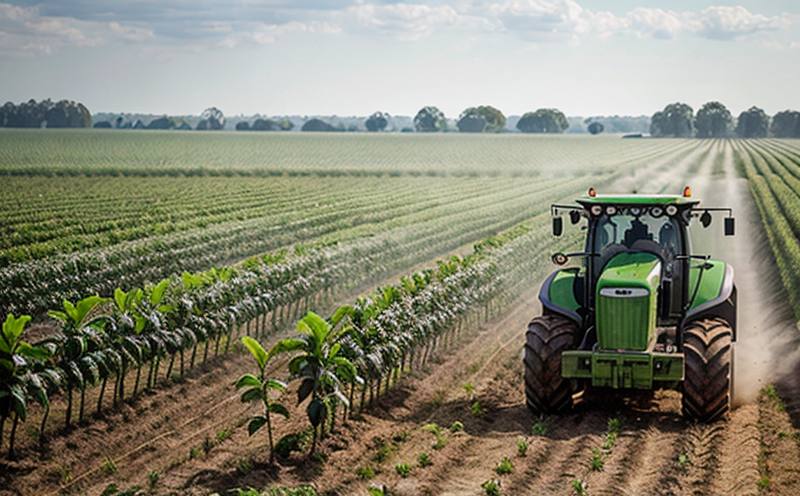BS EN 15662 Agricultural Pesticide Testing by LC MS
The European standard BS EN 15662 specifies a comprehensive methodology for analyzing pesticides in agricultural products using Liquid Chromatography-Mass Spectrometry (LC-MS). This method is pivotal for ensuring the safety and quality of food, feed, and environmental samples. The primary purpose of this standard is to provide a robust framework that aligns with international guidelines like ISO 17025, which ensures laboratories are equipped to perform accurate and reliable pesticide residue detection.
LC-MS technology allows for high sensitivity and selectivity in detecting trace amounts of pesticides. This makes it an ideal tool for compliance testing according to BS EN 15662. The technique involves the separation of compounds using liquid chromatography followed by mass spectrometric analysis, which provides precise identification based on molecular weights.
Sample preparation is a critical step in this process. It includes extracting pesticides from agricultural samples such as fruits, vegetables, grains, and feedstuffs. The extraction method must be optimized to ensure all target compounds are captured without introducing contamination. Common solvents like acetonitrile or methanol are used, followed by cleanup steps using solid-phase extraction cartridges.
The instrumentation required for LC-MS analysis includes a high-performance liquid chromatograph (HPLC) coupled with an electrospray ionization source and a mass spectrometer. Calibration standards must be prepared to ensure accurate quantification of pesticide residues in the samples.
Acceptance criteria under BS EN 15662 define limits for acceptable levels of pesticide residues. These limits are set based on international toxicological evaluations, ensuring that food products do not exceed safe consumption levels as determined by regulatory bodies like the European Food Safety Authority (EFSA).
The standard also emphasizes the importance of method validation to demonstrate accuracy, precision, and robustness. This includes intra-laboratory reproducibility studies and inter-laboratory comparison exercises.
By adhering to BS EN 15662, laboratories can provide reliable data that supports regulatory compliance, consumer safety, and sustainable agricultural practices.
Why It Matters
The implementation of BS EN 15662 is crucial for several reasons. Firstly, it ensures uniformity in testing across different laboratories, which enhances the credibility of results. This standardization is vital for maintaining public trust and confidence in agricultural products.
Agricultural pesticides play a significant role in modern farming by controlling pests, diseases, and weeds. However, excessive or improper use can lead to contamination of food and feed, posing health risks. Compliance with BS EN 15662 helps mitigate these risks by ensuring that pesticide levels are within safe limits.
From an environmental perspective, accurate testing ensures minimal residue in the environment, promoting sustainable agricultural practices. This contributes to biodiversity conservation and reduces pollution from pesticide runoff into water bodies.
In addition, compliance with this standard is a legal requirement for importers/exporters of agricultural products, ensuring that they meet international quality standards set by importing countries.
Environmental and Sustainability Contributions
- Avoiding overuse of pesticides through accurate residue detection promotes sustainable farming practices.
- Reduces the environmental impact of pesticide runoff into water systems, protecting aquatic ecosystems.
- Supports the development of safer agricultural products for human consumption, enhancing public health.
- Facilitates compliance with international and national regulations on pesticide usage, ensuring legal trade.
The standard’s focus on accurate detection and quantification of pesticides plays a key role in minimizing their environmental footprint. By adhering to BS EN 15662, laboratories contribute significantly to the sustainability goals of agricultural industries worldwide.
Use Cases and Application Examples
The application of BS EN 15662 is widespread in various sectors including agriculture, food safety, and environmental monitoring. Here are some use cases:
- Agricultural Products Testing: Ensuring that fruits, vegetables, grains, and other agricultural products meet the required pesticide residue limits.
- Feedstuff Quality Assurance: Detecting pesticides in animal feed to ensure safety for livestock consumption.
- Environmental Monitoring: Analyzing water samples for potential contamination from agricultural runoff.
- Regulatory Compliance: Supporting regulatory bodies in enforcing pesticide usage guidelines and standards.
In practice, laboratories use LC-MS systems to analyze a wide range of pesticides including organophosphates, pyrethroids, and fungicides. The results from these analyses are used by quality managers, compliance officers, R&D engineers, and procurement teams to make informed decisions about product safety and sustainability.





